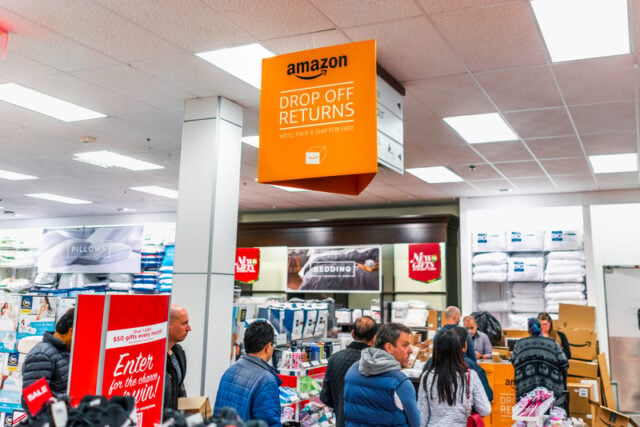Think twice before ordering those shoes in two sizes — sending one pair back might cost you.
According to a report released Oct. 15 by the National Retail Federation and Happy Returns, a logistics company owned by UPS, 72% of U.S. retailers now charge customers money for at least one return method, up from 66% last year.
Over the past few years, retailers have slowly been rolling back one of online shopping’s biggest perks: free returns. The reason? Rising shipping costs, economic uncertainty and the mounting expense of handling the billions of dollars’ worth of merchandise expected to be sent back this year.
Retailers from Zara and H&M to Amazon have introduced small fees for certain returns, signaling a broader recalibration across retail as companies rethink the economics of online shopping. Amazon, for instance, began adding a $1 fee in 2023 for return drop-offs at UPS stores when a free option — like a Whole Foods or Amazon Fresh return location — is nearby.
“It’s a challenging landscape in e-commerce,” Tim Fehr, chief operating officer at Happy Returns, tells Money. “Prepandemic, the focus was on growing as fast as possible and satisfying customers, no matter the cost.”
Postpandemic, as growth slowed and costs rose, merchants began focusing more on refinement and bottom-line diligence, he adds.
“Those trends are continuing, and companies face additional headwinds with some of these regulatory and tariff changes,” Fehr says. “Many merchants are trying to find ways to still succeed.”
This calibration isn’t just a strategic choice; it’s a financial necessity. According to the NRF report, retailers estimate that 15.8% of their total annual sales — both online and in stores — will be returned this year (that’s the equivalent of $849.9 billion).
Online returns alone are projected to account for 19.3% of sales, with Gen Z shoppers leading the way. Shoppers born between 1997 and 2012 averaged nearly eight returns each over the past year. Baby boomers, on the other hand, averaged just five.
The pressures driving these changes go beyond shipping costs. Brandon Yoshimura, a director in consumer retail at Solomon Partners, says the post-pandemic environment has forced companies to rethink what they can absorb financially.
“COVID began a reversal away from ‘frictionless’ free-shipping and free-return e-commerce,” he notes in an email to Money, citing supply chain disruptions, rising container prices and a surge in returns. “Pressure from tariffs, inflation and other costs is forcing companies to look at every piece of their operations to prioritize profitability and unit economics.”
For many retailers, covering these costs is simply too big a hit — especially for companies that already operate on thin margins.
Yoshimura points to examples like Warby Parker, which recently announced it would begin phasing out its Home Try-On program after 15 years, as evidence that retailers are rethinking costly customer conveniences. The eyewear company’s signature program allowed shoppers to order up to five frames to try on at home, with both shipping and returns completely free.
“Over the long term, I think this will discourage costly consumer behaviors [like] buying multiple sizes but also reinforce the importance of physical retailing as a complement to online selling,” he says.
How returns are changing the way we shop online
For years, consumers have grown accustomed to over-ordering, enabled by the conveniences of free and fast shipping — buying multiple sizes, colors or options knowing they could send most of it back for free. But now, those habits can come with a cost. As retailers rush to tack on fees, returns are becoming a bigger consideration in how people shop online.
Free returns, instant refunds and simple drop-off options remain top priorities for consumers — and shoppers are willing to adjust their habits based on a retailer’s policy, according to the NRF report. More people are now checking return policies before making a purchase, and a bad experience can make or break brand loyalty.
In fact, about 82% of consumers say free returns are an important factor when shopping online, up from 76% last year. And 71% say a poor return experience makes them less likely to shop with that retailer again.
At the same time, consumers are finding ways to dodge fees. Some opt for in-store drop-offs or package-free returns, while others pay closer attention to return windows (as some retailers are making those shorter, too).
Even as consumers continue to spend — retail spending reached $732 billion in August, up 5% from a year earlier, according to the Census Bureau — they’re becoming more intentional about what they buy and keep.
The growing cost of returns may curb impulse purchases and shift habits, but experts say it doesn’t spell the end of free returns altogether.
“I don’t think there’s really been a paradigm shift as much as there has been more scrutiny and refinement,” Fehr says. “Many leading merchants continue to offer free returns — and I think many always will.”
Disclaimer
The information contained in South Florida Reporter is for general information purposes only.
The South Florida Reporter assumes no responsibility for errors or omissions in the contents of the Service.
In no event shall the South Florida Reporter be liable for any special, direct, indirect, consequential, or incidental damages or any damages whatsoever, whether in an action of contract, negligence or other tort, arising out of or in connection with the use of the Service or the contents of the Service. The Company reserves the right to make additions, deletions, or modifications to the contents of the Service at any time without prior notice.
The Company does not warrant that the Service is free of viruses or other harmful components













